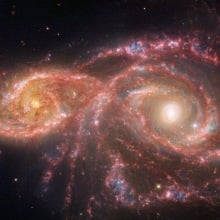When the Hubble Space Telescope snapped a photo of the Sombrero Galaxy 20 years ago, it resembled a hat, with a brim and glowing crown.
But astronomers may have to rename it the visor galaxy. In a new image from the James Webb Space Telescope, which senses the cosmos in infrared rather than visible light, the namesake sombrero doesn't have a top. From Webb's perspective, the galaxy's central hazy bulge disappears, revealing a core with a mirror-smooth finish.
The galaxy's new look may be jarring to avid space fans. Though the cosmic object can't be seen with the naked eye, many amateur astronomers have spotted it with small backyard telescopes.
"The signature, glowing core seen in visible-light images does not shine, and instead a smooth inner disk is revealed," according to the Space Telescope Science Institute in Baltimore, which operates Webb and Hubble for NASA. "The sharp resolution of Webb’s MIRI (Mid-Infrared Instrument) also brings into focus details of the galaxy’s outer ring, providing insights into how the dust, an essential building block for astronomical objects in the Universe, is distributed."

A lot of dust and gas in space obscures the view to distant and inherently dim light sources. But infrared light waves can actually penetrate the clouds. That's how Webb can observe an extremely early period of the universe.
Webb's ability to see through hazy obstacles is demonstrated here with the Sombrero, aka Messier 104, a nearly edge-on spiral galaxy about 30 million light-years from Earth in the constellation Virgo. The galaxy was discovered in 1781 by the French comet hunter Pierre Méchain, one of renowned astronomer Charles Messier’s colleagues.
In the new image, the galaxy has a small bright core centered on a clearer disk peppered with stars. And for the first time, the galaxy's outer ring appears clumpy.
Dust clumps can indicate young star-forming regions, but this galaxy is not much of a baby factory. Astronomers estimate its rings produce less than one star comparable to the sun per year, compared to the Milky Way, which pops out about two per year.
The supermassive black hole that defines its center is also rather sluggish, not gobbling up much material, despite having a mass equivalent to 9 billion suns. That's more than double the scale of Sagittarius A*, the black hole at the center of our own galaxy.
What intrigues scientists the most about the distant Sombrero Galaxy is its 2,000-or-so globular clusters. These clusters contain hundreds of thousands of old stars, held together by gravity. Despite the similar ages of these stars, their masses and other characteristics vary, offering intriguing opportunities for comparisons.
"This type of system," the institute said, "serves as a pseudo laboratory for astronomers to study stars."
Topics NASA













